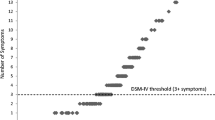Abstract
This paper compares the validity of DSM-III-R diagnoses of oppositional defiant disorder (ODD) and conduct disorder (CD) and an alternative option which is subdivided into three levels according to developmental sequence and severity: modified oppositional disorder (MODD), intermediate CD (ICD), and advanced CD (ACD). Using a sample of 177 boys followed over 3 years, both the DSM-III-R and the alternative diagnostic constructs are evaluated on three criteria: symptom discriminative validity, and diagnostic external and predictive validity. Most DSM-III-R ODD and CD symptoms discriminated between ODD and CD, but exceptions are noted. Additional analyses demonstrated considerable overlap among DSM-III-R oppositional symptoms. The majority of the symptoms proposed for the alternative option could be assigned to a specific level based on acceptable symptom discrimination. External validity lent support to the distinctions between DSM-III-R ODD and CD, and between MODD, ICD, and ACD. MODD was a better predictor than ODD of which boys received a later diagnosis of CD. Suggestions are made for the inclusion and exclusion of symptoms for developmentally based diagnoses of oppositional and conduct disorders.
Similar content being viewed by others
References
Achenbach, T. M. (1978). The child behavior profile: I. Boys aged 6–11.Journal of Consulting and Clinical Psychology, 46, 478–488.
Achenbach, T. M., & Edelbrock, C. S. (1979). The child behavior profile: II. Boys aged 12–16 and girls aged 6–11 and 12–16.Journal of Consulting and Clinical Psychology, 47, 223–233.
Achenbach, T. M., & Edelbrock, C. S. (1983).Manual for the Child Behavior Checklist and Revised Child Behavior Profile. Burlington: University of Vermont.
American Psychiatric Association. (1980).Diagnostic and statistical manual of mental disorders (3rd ed.). Washington, DC: Author.
American Psychiatric Association. (1987).Diagnostic and statistical manual of mental disorders (3rd ed., rev.). Washington, DC: Author.
American Psychiatric Association. (1991).The DSM-IV options book. Washington, DC: Author.
Barkley, R. A., Costello, A., & Spitzer, R. (1989).The development of the DSM-1U-R criteria for the disruptive behavior disorders. Unpublished manuscript, Department of Psychiatry, University of Massachusetts Medical Center, Worcester, MA.
Cohen, J. (1960). A coefficient of agreement for nominal scales.Educational and Psychological Measures, 20, 37–46.
Cohen, P., & Flory, M. (1990). Report on a senes of analyses of attention deficit disorder and oppositional defiant disorder undertaken for DSM-IV. Unpublished Manuscript. New York State Psychiatric Institute, New York, N.Y.
Copas, J., & Loeber, R. (1990). Relative improvement over chance for 2 × 2 tables.British Journal of Statistical and Mathematical Psychology, 43, 293–307.
Costello, A. J., Edelbrock, C. S., Dulcan, M. K., Kalas, R., & Klaric, S. H. (1984).Report on the NIMH Diagnostic Interview Schedule for Children (DISC). Unpublished manuscript, Western Psychiatric Institute and Clinic, Pittsburgh, PA.
Farrington, D., & Loeber, R. (1989). RIOC and phi as measures of predictive efficiency and strength of association in 2 x 2 tables.Journal of Quantitative Criminology, 5, 201–213.
Kolko, D. J., & Kazdin, A. E. (1991). Aggression and psychopathology in matchplaying and firesetting children: A replication and extension.Journal of Clinical Child Psychology, 20, 191–201.
Lahey, B. B., Loeber, R., Quay, H. C., Frick, P. J., & Grimm, J. (1992). Oppositional defiant and conduct disorders: Issues to be resolved for DSM-IV.Journal of the American Academy of Child and Adolescent Psychiatry, 31(3), 539–546.
Lahey, B. B., Loeber, R., Stouthamer-Loeber, M., Christ, M. A. G., Green, S., Russo, M. F. Frick, P. J., & Dulcan, M. (1990). Comparison of DSM-III and DSM-IH-R diagnoses for prepubertal children: Changes in prevalence and validity.Journal of the American Academy of Child and Adolescent Psychiatry, 29, 620–626.
Loeber, R. (1982). The stability of antisocial and delinquent child behavior: A review.Child Development, 53, 1431–1446.
Loeber, R., & Dishion, T. J. (1983). Early predictors of male delinquency: A review.Psychological Bulletin, 94, 68–99.
Loeber, R., Green, S. M., & Lahey, B. B. (1990). Mental health professionals' perception of the utility of children, mothers, and teachers as informants on childhood psychopathology.Journal of Clinical Child Psychology, 19, 136–143.
Loeber, R., Green, S. M., Lahey, B. B., & Stouthamer-Loeber, M. (1989). Optimal informants on childhood disruptive behaviors.Development and Psychopathology, 1, 317–337.
Loeber, R., Lahey, B. B., & Thomas, C. (1991). The diagnostic conundrum of oppositional defiant disorder and conduct disorder.Journal of Abnormal Psychology, 100, 379–390.
Loeber, R., & Stouthamer-Loeber, M. (1987). Prediction. In H. C. Quay (Ed.),Handbook of juvenile delinquency (pp. 325–382). New York: John Wiley & Sons.
Loeber, R., Stouthamer-Loeber, M., Van Kammen, W. B., & Farrington, D. P. (1991). Initiation, escalation and desistance in juvenile offending and their correlates.Journal of Criminal Law and Criminology, 82, 36–82.
Olweus, D. (1979). Stability of aggressive reaction patterns in males: A review.Psychological Bulletin, 86, 852–857.
Robins, L. (1986). Changes in conduct disorder over time. In D. C. Farren & J. D. McKinney (Eds.),Risk in intellectual and psychosocial development (pp. 227–259). New York: Academic Press.
Spitzer, R. L., Cohen, J., Fleiss, J. L., & Endicott, J. (1967). Quantification of agreement in psychiatric diagnosis.Archives of General Psychiatry, 17, 83–87.
Stattin, H., & Magnusson, D. (1989). The role of early aggressive behavior in the frequency, seriousness, and types of later crimes.Journal of Consulting and Clinical Psychology, 57, 710–718.
Stouthamer-Loeber, M. (1986). Boys who lie.Journal of Abnormal Child Psychology, 14, 551–564.
Zimring, F. E. (1979). American youth violence: Issues and trends. In N. Morris & M. Tonry (Eds.),Crime and justice: An annual review of research (Vol. 1, pp. 67–107). Chicago: University of Chicago Press.
Author information
Authors and Affiliations
Additional information
This research was supported by a grant from the John D. and Catherine R. MacArthur Foundation to the American Psychiatric Association, and grant 1-RO1-MH42529-04 from the National Institute of Mental Health. The authors are indebted to Paul Frick for his advice with some of the statistical analyses, and particularly to Ms. Judith Navratil for her expert help in data collection.
Rights and permissions
About this article
Cite this article
Loeber, R., Keenan, K., Lahey, B.B. et al. Evidence for developmentally based diagnoses of oppositional defiant disorder and conduct disorder. J Abnorm Child Psychol 21, 377–410 (1993). https://doi.org/10.1007/BF01261600
Revised:
Issue Date:
DOI: https://doi.org/10.1007/BF01261600




